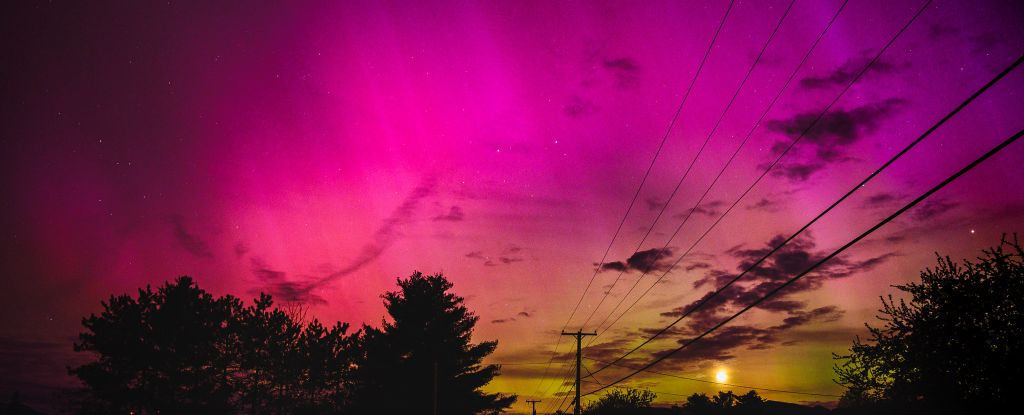For the last few nights, Earth has been bathed in green and red light that shimmers across the skies – and more is on the way.
That’s because we’ve been buffeted by solar storms, as huge outflows of material that exploded from the Sun slam into our magnetic field.
This is not an uncommon occurrence, but what makes these current solar (or geomagnetic) storms so noteworthy is their remarkable power. We haven’t seen a solar disruption this big since the Great Halloween Solar Storms of 2003.
Although such a huge event has the potential to make a bit of a mess on Earth, we appear to have escaped more or less unscathed so far.
The result: absolutely jaw-dropping auroras that dance across Earth’s skies, to latitudes far lower than are usually treated to these wondrous spectacles.
For several nights in a row, these conditions have persisted, producing two G5-level geomagnetic storms. These are labeled as “extreme”, the most powerful class of solar storms that wrack our planet. And they can be dangerous.
The Great Halloween Storms produced power grid fluctuations across North America, a power outage in Sweden, and destroyed 12 power station transformers in South Africa.
The current solar storms have not, as far as we know, produced any damage, although power grid irregularities have been reported. With the storms waning in intensity, so too is the threat of danger; but more solar storms could be looming in the near future.
The culprit is a sunspot region named AR 3664 that’s currently crossing the face of the Sun. This huge region is visible without a telescope, if you still have your eclipse glasses kicking around – do NOT look directly at the Sun without eye protection.
It’s also extremely active, having spat out several X-class flares, the most powerful flares of which our Sun is capable. But flares alone don’t have this much of an effect on Earth. The big guns here are the coronal mass ejections (CME) that sometimes occur in concert with flares, released from sunspot regions where solar magnetic field reconnections cause huge bursts of energy.
CMEs are massive expulsions of plasma and magnetic fields that are ejected from the Sun out into the Solar System, in the range of billions of tons. And they really are something to behold.
Midst among the excitement of the very first Extreme G5 geomagnetic storm since 2003, sunspot region 3664 continued doing what is is best at: producing major solar flares. It produced it’s strongest solar flare thus far and the second strong solar flare of the current Solar… pic.twitter.com/G4ImkAr42j
— SpaceWeatherLive (@_SpaceWeather_) May 11, 2024
It can take a few days to reach Earth, but when a CME smacks into our planet’s magnetic field, it makes a bit of a ruckus. The particles in the CME get accelerated along Earth’s magnetic field lines until they are dumped out into our atmosphere, where they interact with particles that are already there.
One part of this is the aurora. You might think of this as primarily green, and you’re not wrong. But when an aurora is particularly energetic, we get to see huge walls of red glow lighting up the sky. This has to do with particles involved and the altitude at which they are interacting.
Green aurora is caused by solar particles interacting with oxygen at altitudes between 100 and 300 kilometers (62 to 186 miles). But the brilliant scarlet light we’ve been seeing is the result of interaction with oxygen at higher altitudes, between 300 and 400 kilometers. And they have to be at least 10 times as bright as green auroras to be seen with the naked eye.
Other effects of the solar storm include the aforementioned power grid anomalies, which are the result of currents generated by atmospheric particle interactions. These currents create surges in the power grids that can cause damage. And satellites and high-frequency radio communications can be disrupted, although most people won’t notice this.
AR 3664 is, at time of writing, about to disappear behind the disk of the Sun, but its rowdiness could continue. It’s just spat out another X-class flare, and although it’s no longer pointed in our direction, any CMEs could send particles out to contribute to ongoing solar storms.
The NOAA is predicting moderate geomagnetic storms until 02:00 UTC on 13 May. But with the Sun about to (or in the midst of) hit the peak of its 11-year activity cycle, don’t be surprised if more sunspot regions start showing us a good time.
You can track whether you’re likely to see auroras on the NOAA’s Space Weather Prediction Center website for the northern hemisphere, and the Australian Bureau of Meteorology’s Space Weather Forecasting Centre for the south.
Now get out there and enjoy the show.





